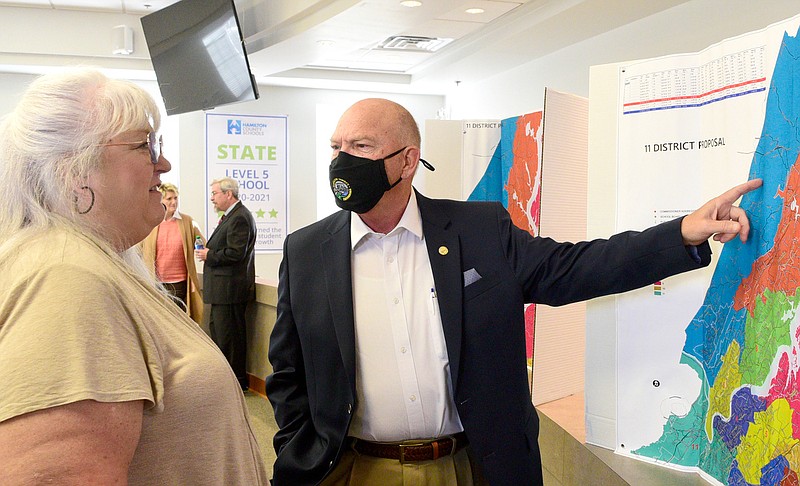A Hamilton County redistricting workshop that began with a bang in the earlier county commission meeting Wednesday ended with a whimper and the new political map being substantially done.
Charges of racism, voter suppression and disenfranchisement that have been leveled throughout the process by groups and individuals who wanted to slow down the already delayed boundary redrawing were put to the lie by the methodical, even-handed way in which the map was all but completed.
County commissioners will vote on the new, 11-district map for the first time at the commission meeting next Tuesday, but changes may still be made before the vote.
Wednesday's workshop left commission Chairman Sabrena Smedley breathing a sigh of relief.
"It was a big step in the right direction," she said of the process. "[The commission members] all got what they asked for, as best as can be done."
Hours earlier, District 6 Commissioner David Sharpe had accused Smedley's handling of things as "nothing short of dictatorial. This is old-school, Boss Hog-style politics [in] trying to ram a map through without proper consideration."
"It's unacceptable," he said. "It's completely void of transparency - no matter how often or loudly you refer to it as transparent does not make it true."
Earlier, Smedley - in response to previous accusations - had said Sharpe had "bullied" and was "threatening" employees of the county's GIS department, which handles the software for drawing the maps.
"They are Hamilton County employees," she said, "and they should be treated with dignity and respect ... You had no right to treat a Hamilton County employee like you did."
The truth is the process has been transparent from start to finish, with tweaks to the map done in public, with public comment allowed at each meeting and with district meetings on the process held by every commissioner to hear from their constituents.
Though speaking with perhaps a touch of hyperbole, District 8 Commissioner Tim Boyd called it "the most transparent redistricting [process] ever in the history of Hamilton County."
Even District 4 Commissioner Warren Mackey, who during previous weeks had been among those who had made some of the vague voter suppression comments, called it "the most transparent [process] I've been part of."
As the six commission members present (with District 5 Commissioner Katherlyn Geter, who was sick, on the phone) were wrangling with district and census block lines during the workshop, they were trying to ensure at least two things - that Districts 4 and 5 retained a Black majority, and that the deviation of the combined total of each district from the average number of residents per district was less than 10%.
To achieve those goals, they had to break one of their original hopes - not to have district lines cross the Tennessee River. But to allow District 1 Commissioner Randy Fairbanks to retain the Flat Top Mountain portion of his North Hamilton County district, they extended the lines of District 2 Commissioner Chip Baker from Signal Mountain across the river to Elder Mountain.
Smedley had noted earlier that - despite the push from some groups to slow down - the county already was behind in its redistricting process. She said half of the state's 95 counties had largely finished their redistricting work and that more than a fourth of them were completely done.
"We knew going into this that everything at the end would not be perfect," she said. "We all had to give up something. Everybody got to shift lines. Nothing was one-sided. We saw that give-and-take play out."
Unless something drastic happens at the commission meeting Tuesday, members will be voting to expand commission districts from nine to 11 to accommodate the county's increase in population. District 10 will be in the fastest-growing eastern edge of the county, while District 11 will include Lookout Valley, Lookout Mountain and all of South Chattanooga.
If voting patterns remain consistent, District 10 is likely to become a Republican stronghold, while District 11 will lean toward Democrats.
Earlier this week, county commissioners and Hamilton County Board of Education members did not come to a consensus on whether school board districts would mirror the 11 districts the county is contemplating or remain at nine. Attorneys for both boards indicated the number would remain at nine unless changed by an act of the legislature.
Since school board races are nonpartisan, the two bodies have time to work out that decision in time for the August 2022 election.
Complicating that decision, though, is the current special session of the Tennessee legislature, which is considering allowing school board elections to be conducted on a partisan basis and candidates to run as representatives of a political party. Yet the bill does not specify whether representatives of a party would be chosen in a primary or if all comers would run together.
That'll be a consideration for another day, but at least the redistricting chaos seems to be largely behind the county for another 10 years.
